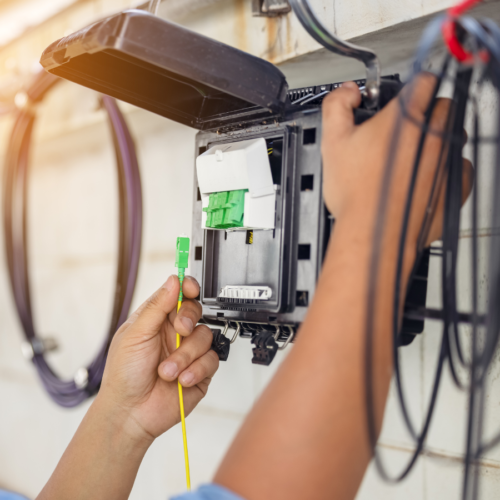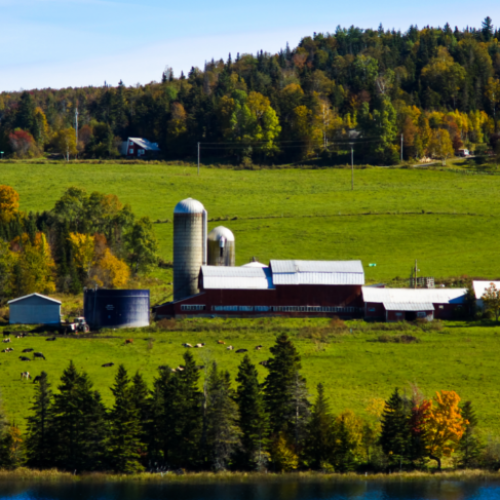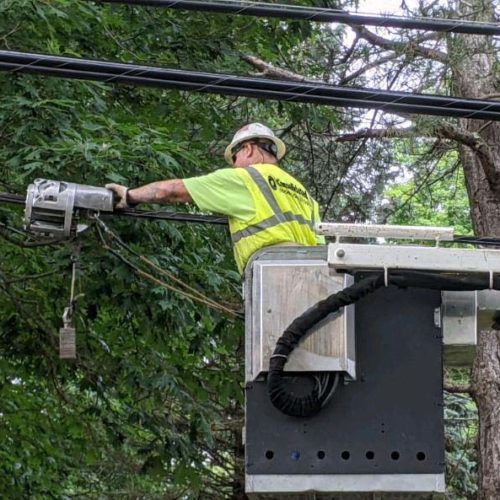Accessing rural broadband to bridge the digital divide
This article appears in the 2019-2020 edition of CSG East’s Perspectives Magazine.

Credit: zentilia/Shutterstock.com
Nearly five years ago, the rural town of Leverett, Massachusetts, resolved to enter the digital age.
Residents were determined to get rid of their slow Internet service, which was transmitted over aging copper wires. The wires were so degraded that when it rained and they got wet, the connection was spotty. Local officials had tried to persuade the private sector to build a high-speed fiber-optic system, to no avail. So they took matters into their own hands.
The town formed the Leverett Municipal Light Plant, a public entity permitted by state law to sell telecommunications services. Next, it obtained a $40,000 planning grant from a state agency that provides funding for broadband infrastructure in underserved areas. Then officials appealed to voters, who approved $3.6 million in borrowing to hire a contractor to lay down fiber-optic cable. The town would own and operate the infrastructure under the authority of the municipal light plant. The plant contracted with an Internet service provider, and in August 2015, it began providing lightning-fast service to the town’s 1,800 residents.
“Before, people couldn’t sell their homes. Now housing prices are coming back,” said Deb Socia, executive director of Next Century Cities, a nonprofit that helps communities access affordable broadband, during a conference organized by CSG/ERC’s Agriculture Policy Committee in Delaware last April.
Across the nation, closing the digital divide has become essential to the functioning of society, as more and more aspects of daily life become digitized — from homework assignments to job applications and health care services. And yet, more than 21 million Americans do not have access to broadband, according to the Federal Communications Commission (FCC). Several factors, including terrain, population density, and demographics, discourage the buildout to rural and low-income areas, because those projects typically result in a lower return on investment for broadband providers.
During 2019, CSG/ERC’s Agriculture Policy Committee met with Socia and other experts working to overcome these hurdles. In a series of meetings, they discussed options to assist officials from rural and underserved communities in the Northeast who are hoping to bring their constituents into the era of modern telecommunications.

U.S. Congresswoman Lisa Blunt Rochster (DE) (sixth from right) addresses state officials during the CSG East rural broadband conference in Wilmington in April 2019.
A National Problem
At least 39 percent of residents in rural areas lack access to basic broadband, which the FCC defines as 25 Mbps (megabits per second) download speeds and 3 Mbps upload speeds. Experts note that this definition is misleading, because those speeds are extremely slow compared with fiber-optic service, which can deliver data at speeds up to 1,000 Mbps.
“It’s like putting someone on the bike path when the rest of the country is on a major eight-lane highway. That’s a very small amount of data at a very low speed,” said Harvard University law professor Susan Crawford, referring to the FCC definition in an interview with Vox.com in January 2019.
Fiber optic carries data across thin glass wires inside a larger protective cable. The data is transferred via light signals, and the connection doesn’t require electricity to operate and has nearly unlimited capacity. Currently, some 25 percent of the United States has access to fiber, predominantly in densely populated urban areas.
In her book, Fiber: The Coming Tech Revolution—and Why America Might Miss It, Crawford argues the widespread lack of access to fiber networks is placing U.S. communities at an economic disadvantage. She points to nations, including China, South Korea, and Sweden, that have made it a national priority to create affordable fiber networks for their citizens. That compares with the United States, where telecommunication providers primarily offer slow, outdated technologies that are overpriced, particularly in rural areas. Crawford adds that federal and state policies have often stood in the way of fiber networks.
Nevertheless, Crawford and others emphasize that many rural towns are taking charge of their technological futures. Nationwide, more than 500 municipalities have invested in public networks, using innovative financing models to lower costs for residents when existing cable or telephone companies do not offer competitively priced services.
For example, a municipal electric utility in Chattanooga, Tennessee, paid for a broadband buildout as part of a new smart-grid initiative for the city that was enabled by a federal stimulus grant. The savings produced by the smart grid, plus revenue from access fees paid by the utility’s Internet access business, covered the financing and operating costs of the smart grid — and would have done so even if the utility had not received the grant, asserts a recent report from the Berkman Klein Center for Internet & Society at Harvard.
Other municipalities have laid down broadband through cooperatives originally created to provide telephone and electrical service for rural communities that historically were not served by commercial providers.
Legal Barriers to Local Authority
Certain circumstances make it challenging for municipalities to take the approach that Leverett pursued.
Leverett benefited in part from its ability to connect to a regional network called MassBroadband 123, created by the Massachusetts Broadband Institute, a state agency, which used a matching federal economic stimulus grant to finance an $89.7 million “middle-mile” fiber-optic network. The project, completed in 2013, comprises 1,200 miles of fiber-optic infrastructure that includes Internet connections at more than 1,100 “community anchor institutions,” such as libraries, schools, stations, and government buildings, in 123 communities in western and central Massachusetts. Leverett funded the “last mile” connection to residents’ homes.
Leverett was also aided by its ability to incorporate as a municipal light plant to sell telecommunications services, a right that does not exist in every state. In fact, more than half of U.S. states have laws that bar local authorities from building a municipal network, according to Next Century Cities. The organization estimates that more than 11 million Americans who do not have access to broadband — over half the country’s estimated unconnected population — live in states where municipal networks are banned by state legislation. In some states, providers have successfully lobbied state officials to approve legislation that creates legal barriers preventing towns from having authority.

At least 39 percent of residents in rural areas lack access to basic broadband.
Credit: Chris Caserta
“We’ve got to solve this problem in New England in these rural areas,” said Socia. “We can’t allow folks to have second-class access.”
There are financial hurdles for local governments, as well. Throughout the country, broadband technologies are primarily being deployed by the private sector. Tom Coverick, a managing director of KeyBanc Capital Markets, said investors are reluctant to underwrite municipal broadband networks because they consider the investments unproven and risky.
“Telecom spooks our investors. They don’t view it as a utility yet. They’re not certain about the technology or the competition,” said Coverick during the April meeting.
His advice was that municipalities assume enough risk with a project to convince investors they have “skin in the game,” by offering assets other than network revenue as a backstop for a bond.
The Role of the Federal Government
Some experts, concerned that disparities in broadband access across American society could have adverse economic and social consequences for those left behind, assert that the federal government should play a more active role in addressing the digital divide.
Two primary federal vehicles direct money to fund broadband infrastructure: the broadband and telecommunications programs at the Rural Utilities Service of the U.S. Department of Agriculture and the Universal Service Fund programs under the FCC. The two agencies provide billions in funding each year for rural broadband, and in 2018 and 2019, Congress appropriated more than $1 billion for the Rural Utilities Service to conduct a new broadband loan and grant pilot program, the ReConnect Program.
Sometimes, the agencies have agendas that are at odds with one another. In a column published in The New York Times in February 2019, Christopher Ali, an assistant professor at the University of Virginia, said the resulting lack of coordinated federal policies has enabled major telecommunications companies to receive a large portion of federal funds with low regulatory accountability. Added to that are complex grant and loan stipulations that make it difficult for communities to apply for funding.
Ali and other observers cite the need for a single agency to coordinate federal expenditures, like the wildly successful Rural Electrification Administration, created in 1935 by President Franklin Roosevelt to provide loans and grants to rural electric and telephone companies. Within 20 years of its establishment, the program had brought electricity to nearly every farm across America.
The Need for Improved Mapping
Nationwide, another challenge is lack of accurate data showing which communities are underserved.
The FCC is required by law to collect broadband information, and starting in 2019, the agency assumed responsibility for developing a comprehensive map of broadband access in the United States. The data is critical to local communities, because the FCC uses it to determine where to direct billions of dollars per year to deploy broadband in underserved areas. However, much of the current data has been criticized as incomplete or misleading.
For example, a unit of geography such as a census tract or a census block is considered “covered,” and ineligible for federal funding, if at least one business or residence in that area can obtain broadband.
“This is very problematic because the blocks vary so much in size,” said Brent Legg, vice president of government affairs at Connected Nation, a nonprofit that provides broadband mapping services for states and local communities. “There are eight blocks in the U.S. that are the size of Connecticut. In Alaska, one block is the size of New Jersey,” said Legg during the April conference.
Historically, the data has been self-reported by broadband service providers and not independently verified outside of the FCC. In response to public criticism, last August the FCC adopted a new process for collecting data. The process, expected to be implemented during a period of 12 to 18 months, would require broadband service providers to submit geospatial broadband coverage maps — which provide greater granularity than census blocks — indicating where fixed broadband service is actually made available. The new process would also implement a crowdsourcing mechanism for public feedback, as individual consumers likely know whether they have access to broadband, according to a report from the Congressional Research Service.
Going forward, the CSG/ERC Agriculture Committee will continue to track successes — and failures — in rural broadband expansion in the region, and connect members in underserved areas with experts who can offer suggestions for a path forward.





